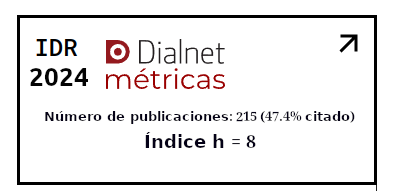School virtues perceived by Ecuadorian students and teachers: differences according to sex, establishment and roles
Keywords:
Perceived virtuousness; school organizations; positive organizational scholarshipAbstract
The objective of the study was to evaluate the perceived virtuousness in school organizations and the differences according type of school (fiscal, municipal); sex (woman, man) and role (students, teachers). This is an instrumental study based on the analysis of the factorial structure and the reliability of a questionnaire to evaluate virtues in schools (VPOE); and, a transversal descriptive study that analyzed differences according sex, role and type of school organizations in relation to perceived virtues. The study sample were 550 students (49.28% women) and 105 teachers (47.62% women). The factor analysis determined a four-factor model that explains 47.49% of the variance. The questionnaire showed adequate indicators of reliability. The multivariate analysis showed significant differences in favor of women (λ = 0.96; F (5,643) = 5.49; p < .01; η2p = 0.04), fiscal establishments (λ = 0.98; F (5,643) = 3.07; p < ,01; η2p = 0.02) and teachers (λ = 0.92; F (5,643) = 5.493; p < 0.010; η2p = 0.08) in relation to the dimensions of the VPOE. In this way, there is a brief instrument with adequate psychometric properties for the measurement of PVSO in Ecuadorian contexts. Significant differences were identified according the analyzed groups.
Downloads
References
Anastasi, A. (1974). Test psicológicos. Madrid: Aguilar.
Asad, H., Naseen, R., y Faiz, R. (2017). Mediating effect of ethical climate between organizational virtuousness and job satisfaction. Pakistan Journal of Commerce and Social Sciences, 11 (1), 35-48. Recuperado de http://www.jespk.net/publications/357.pdf
Barclay, L. A., y Markel, K .S. (2012). Virtue theory and organizations: considering persons with disabilities. Journal of Managerial Psychology, 27 (4), 330 -346. doi: https://doi.org/10.1108/02683941211220153
Bollen, K., y Long, J. (1993). Testing structural equation models. Sage: Newbury Park, CA.
Bonder, G. (2013). La inclusión del enfoque de género en las ciencias. En, XII Conferencia Regional sobre la Mujer de América Latina y el Caribe (pp. 15-18). Santo Domingo: CEPAL. Recuperado de http://www.cepal.org/12conferenciamujer/noticias/paginas/0/49920/Gloria-Bonder-presentacion-panel6-CRM_XII.pdf
Cameron, K., Bright, D., y Caza, A. (2004) Exploring the relationships between organizational virtuousness and performance. American Behavioral Scientist, 47, 766-790. doi: 10.1177/0002764203260209.
Cameron, K., Dutton, J.E., y Quinn, R.E. (2003). Positive organizational scholarship (pp. 3-13). San Francisco, USA: Berrett-Koehler. Recuperado de www.bkconnection.com/static/Positive_Organizational_Scholarship_EXCERPT.pdf
Cameron, K., Mora, C., Leutscher, T., y Calarco, M. (2011). Effects of positive practices on organizational efectiveness. The Journal of Applied Behavioral Science XX(X) 1–3. doi: 10.1177/0021886310395514
Cameron, K., y Winn, B. (2012). Virtuousness in organizations. In, K. Cameron y G. Spretizer, The oxford handbook of positive organizational scholarship (pp. 231 – 243). London, United Kigdmon: Oxford Library of Psychology.
Capella, M., y Andrade, F. (2017). Hacia una psicología ecuatoriana: una argumentación intergeneracional sobre la importancia de la cultura y la glocalidad en la investigación. Teoría y Crítica de la Psicología, 9, 173-195. Recuperado de http://www.teocripsi.com/ojs/
Castro-Solano, A. (2010). Percepción del clima de aceptación en organizaciones: Un estudio con líderes argentinos. Boletín de Psicología, 98, 41-53. Recuperado de https://www.uv.es/seoane/boletin/previos/N98-3.pdf
Cattell, R. B. (1978). The scientific use of factor analysis in behavioral and life sciences. New York, NY: Plenum Press.
Caza, A., y Cameron, K. S. (2008). Positive organizational scholarship: What does it achieve? In, S. Clegg and C. L. Cooper (Eds.), The sage handbook of organizational behavior: Macro Approaches (Volume 2). New York: Sage.
Chun, R. (2005). Ethical character and virtue on organizations: An empirical assessment and strategic implication. Journal and Business Ethic, 57, 269 - 285. Recuperado de https://link.springer.com/article/10.1007/s10551-004-6591-2
Cohen, J. (1988). Statistical power analysis for the behavioral sciences. (2 ed). Hillsdale, NJ: Erlbaum.
Cupani, M. (2012). Análisis de ecuaciones estructurales: conceptos, etapas de desarrollo y un ejemplo de su aplicación. Revista Tesis, 1, 186-199. Recuperado de https://revistas.unc.edu.ar/index.php/tesis/article/view/2884
Curran, T., y Wexler, L. (2016). School-based positive youth development: A systematic review of the literature. Journal of School Health, 87, 1, 71–80. doi: 10.1111/josh.12467
Delgado, A. E., Escurra, L. M., y Torres, W. (2006). La medición en psicología y educación: teoría y aplicaciones. Lima: Editorial Hozlo.
Ferrando, P., y Anguiano-Carrasco, C. (2010). El análisis factorial como técnica de investigación en Psicología. Papeles del Psicólogo,31(1), 18-33. Recuperado de http://www.redalyc.org/pdf/778/77812441003.pdf
Glutting, J. (2002). Some psychometric properties of a system to measure ADHD. Measurement and Evaluation in Counseling and Development, 34, 194-209.
Gómez, B. J., y Mei Ang, P. (2007). Promoting positive youth development in schools. Theory into practice, 46, 97–104. https://doi.org/10.1080/00405840701232752
Harman, H. H. (1976). Modern factor analysis. Chicago: Univ of Chicago press.
Hu, L., y Bentler, P. (1995). Evaluating model fit. In, R. H. Hoyle (Ed.), Structural equation modeling: Concepts, issues, and applications (pp. 76-99). Thousand Oaks, CA, US: Sage Publications.
Jach, H., Sun, J., Loton, D., Chi, T., y Waters, L. (2017). Strengths and subjective wellbeing in adolescence: Strength-based parenting and the moderating effect of mindset. Journal of Happiness Studies, 1-20. doi:10.1007/s10902-016-9841-y
Kelly, J., y Cameron, K. (2017) Applying positive organisational scholarship to produce extraordinary performance. In, Proctor, C. (eds) Positive psychology interventions in practice. Cham: Springer.
Kline, P. (2000). Handbook of psychological testing. London: Routledge.
Lerner, R. M., Lerner, J. V., Almerigi, J. B., Theokas, C., Phelps, E., Gestsdottir, S., Naudeau, S., Jelicic, H., Alberts, A., Ma, L., Smith, L. M., Bobek, D. L., Richman-Raphael, D., Simpson, I., DiDenti Christiansen, E., von Eye, A. (2005). Positive youth development, participation in community youth development programs, and community contributions of fifth-grade adolescents: Findings from the rest wave of the 4-H Study of Positive Youth Development. Journal of Early Adolescence, 25, 17-71. doi: https://doi.org/10.1177/0272431604272461
Lévy, J. P., y Varela, J. (2003). Análisis multivariable para las ciencias sociales. Madrid: Prentice Hall.
Lupano-Perugini, M. L. (2017). Virtudes organizacionales, performance y satisfacción laboral: Diferencias según variables individuales y organizacionales en empleados argentinos. Psicodebate, 17, 35 - 50. doi: 10.18682/pd.v17i1.637
Lupano-Perugini, M. L., y Castro-Solano, A. (2018). Virtudes organizacionales y características positivas asociadas a performance y satisfacción laboral. Acta Psiquiátrica y Psicológica de América Latina, 60(1), 28-39.
McDonald, R. P. (1985). Factor analysis and related methods. Hillsdale: LEA.
Montero, I., y León, O. (2007). A guide for naming research studies in psychology. International Journal of Clinical and Health Psychology, 7, 847-862.
Nartgun, S., y Dilekci, U. (2016). Teacher views on administrators’ leadership styles and level of organizational virtuousness. Anthropologist, 24(1), 363-372. doi: https://doi.org/10.1080/09720073.2016.11892026.
Nunnally, J., y Bernstein, I. (1995). Teoría psicométrica. México: Mc Graw Hill.
Obst Camerini, J. (2014). La terapia cognitiva: integrada y actualizada. Buenos Aires: C.A.T.R.E.C.
Palomera Martín, R. (2017). Psicología positiva en la escuela: Un cambio con raíces profundas. Papeles del Psicólogo, 38 (1), 67-71. Recuperado de http://www.papelesdelpsicologo.es/pdf/2823.pdf
Peterson, C. (2006). A primer in positive psychology. New York, NY: Oxford University Press.
Rao, M. A., Donaldson, S. I., y Doiron, K. M. (2015). Positive psychology research in the Middle East and North Africa. Middle East Journal of Positive Psychology, 1(1), 60-76.
Rial Boubeta, A., Varela Mallou, J., Abalo Piñeiro, J. y Lévy Mangin, J. P. (2006). El análisis factorial confirmatorio. En, J.P. Lévy Mangin y J. Varela (Eds.), Modelización con estructuras de covarianzas en ciencias sociales (pp. 119-143). Coruña: Netbiblo. Recuperado de: https://issuu.com/psiencia/docs/7_2_
Salanova, M. (2010). Psicología de la salud ocupacional. Madrid: Síntesis.
Seligman, M. E. P. (1999). The president´s address. American Psychologist, 54, 559-532. Recuperado de www.sas.upenn.edu/psych/seligman/aparep98.htm
Seligman, M. E. P. (2011). Flourish: A visionary new understanding of happiness and well-being. New York, NY: Free Press.
Tabachnick, B., y Fidell, L. (1996). Using multivariate statistics (3 ed.). New York: Harper Collins Publishers.
Unda-Villafuerte, F. (2018). Organizaciones escolares virtuosas, bienestar psicológico en adolescentes y liderazgo auténtico en docentes. Universidad de Palermo. Tesis doctoral. Recuperado de https://dspace.palermo.edu/dspace/bitstream/handle/10226/1956/UNDA_Virtuosidad%2C%20bienestar%20y%20liderazgo.pdf?sequence=1&isAllowed=y
Published
How to Cite
Issue
Section
License
Copyright (c) 2020 ACADEMO Revista de Investigación en Ciencias Sociales y Humanidades

This work is licensed under a Creative Commons Attribution 4.0 International License.








